The Wildlife Garden
This plea to anyone and everyone to make their garden wildlife friendly rides on the back of my usual mantra about extinction. It rarely happens in big obvious and rapid catastrophes. It happens all around us, so slowly that we get used to it.
First a species disappears from a garden, a field or a valley, then from a parish, then a county, then a region. It might be at this stage that we realise that the species has become scarcer, not just locally but everywhere. But maybe not. By this time, there are too few populations in a fit state to study, in order to find the cause.
Red squirrels and Hedgehogs.
Let’s take the red squirrel. They’re not extinct everywhere, but they’re not out of the woods either. Red squirrels are very much in the woods. I used to know people who knew red squirrels as a common sight in their English neighbourhoods. They witnessed its decline and disappearance and the arrival of the grey squirrel. Now, most people in the same places would be astonished to see a red squirrel and find it perfectly normal to see greys.
Hedgehogs may well be in the same position that red squirrels were in in the 1940s, along with countless other species whose names we don’t always know. Extinction is often a silent killer, taking away, not just species, but culture that has built on thousands of years of reliable biodiversity around it.
With the fun that nature gives gone, we turn to TVs, sport, gaming consoles etc and forget what we have lost. Our children may never know. We ignore the spread of extinction often because it seems unfathomable or too big or difficult to stop. But each one of us can help restore nature to its former glory. A single person can make a huge difference either locally or internationally; both are important!
The Wild Corner
The wild corner collection was created to share the importance of plants that we’ve become accustomed to thinking of as a nuisance. Starting with nettles, dock and thistle, we’ve called these the ‘holey’ trinity. Those holes show that life is abundant amongst them. If we can all spare a corner for these plants, together we can all make a difference. They are plants that need no attention once established, so by doing nothing in your wild corner, you’re helping the planet!
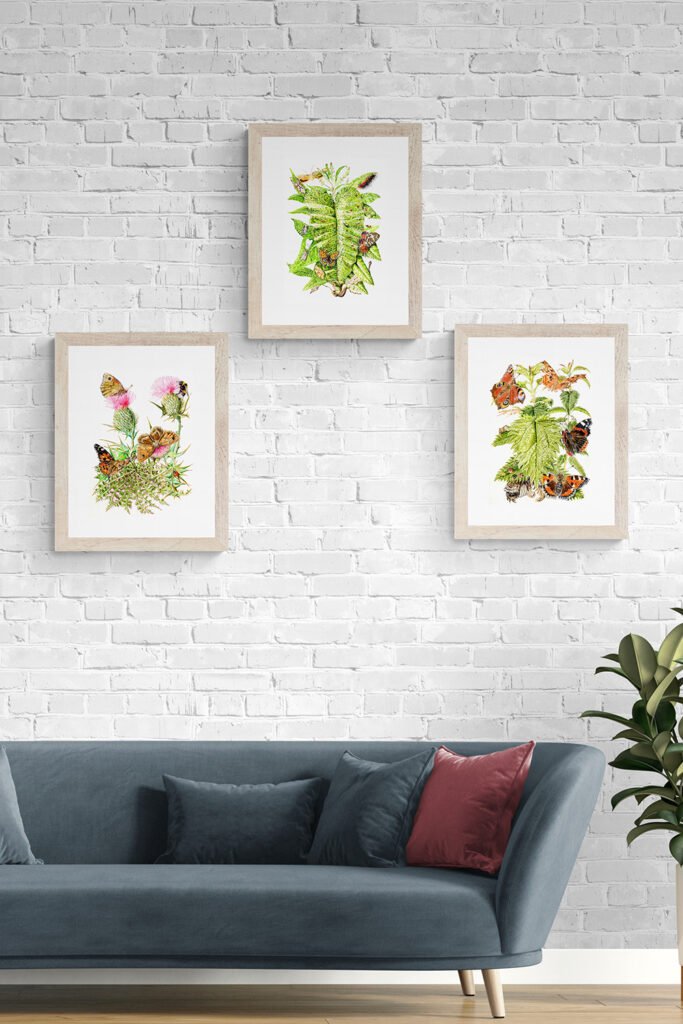
We’ve talked about our ‘holey’ trinity before, but here they are in more detail.
The ‘Holey’ Trinity
The following plants are all common weeds and need little or no encouragement. Anyone worried about them taking over the garden simply needs to ‘garden’ them out if they ever become a nuisance. I tend to graze with shears and secateurs. Just as grazers control the plants in a grassland or pasture, so you can control garden plants by nipping them back. For more immediate satisfaction they can be dug out but it’s all just gardening. Also they can go in pots which will reduce the chance of them taking over.
Thistles
The text below refers mainly to the spear thistle (Cirsium vulgare). The creeping thistle can be hard work if you ever want to remove it as it has deep penetrating roots. They tend to be a sign of enriched and over-worked ground, either by fertilising or over grazing. But we must see them as the toughest survivors of a lost assemblage of the team that once supported our invertebrate and bird diversity with ease.
The thistles are beautiful when you really look at them and they feed many insects. We even had a meadow brown butterfly visit the garden (a first in any garden for me – they are something to enjoy when out and about but it came to me and it came because of the thistle!). The thistle flower ‘died’ back and the remaining seed head burgeoned, threatening to spread its dreaded seeds everywhere. But most of the seeds were gathered by goldfinches and oh… what a spectacle that was.
We have, since, had thistles appear in places where we didn’t want them and had to take serious action to prevent them over-running us. Failure seemed inevitable at first, but salvation came with the use of gloves and a trowel. Sometimes they need attacking two or three times but weeding is part of gardening; right? ‘Weeds’ are not the enemy, they are just other plants trying to survive in a world obsessed with hardy exotics, paving, ploughing and control.
The painted lady butterfly, seldom, if ever, breeds in the UK. ‘She’ migrates from Europe and north Africa to delight our eyes with her beauty. You are most likely to see her feeding on non-native Buddleia, a rich source of nectar. But the native plant that attracts her, is, in my experience, most often thistle. If she is ever to raise her young here, they will most likely feast on this plant – Cirsium.
Weeds Act!
I should probably say at this point that creeping and spear thistles are included in the Weeds Act 1959 which states… “Where the Minister… is satisfied that there are injurious weeds to which this Act applies growing upon any land he may serve upon the occupier of the land a notice in writing requiring him, within the time specified in the notice, to take such action as may be necessary to prevent the weeds from spreading..”. They have enemies in high places!
This does not mean it is illegal to allow them to grow, but if it worries you at all there are alternatives. Teasel is great and easily controlled. But you can grow all the plants described here in plant pots and move them around to suit yourself.
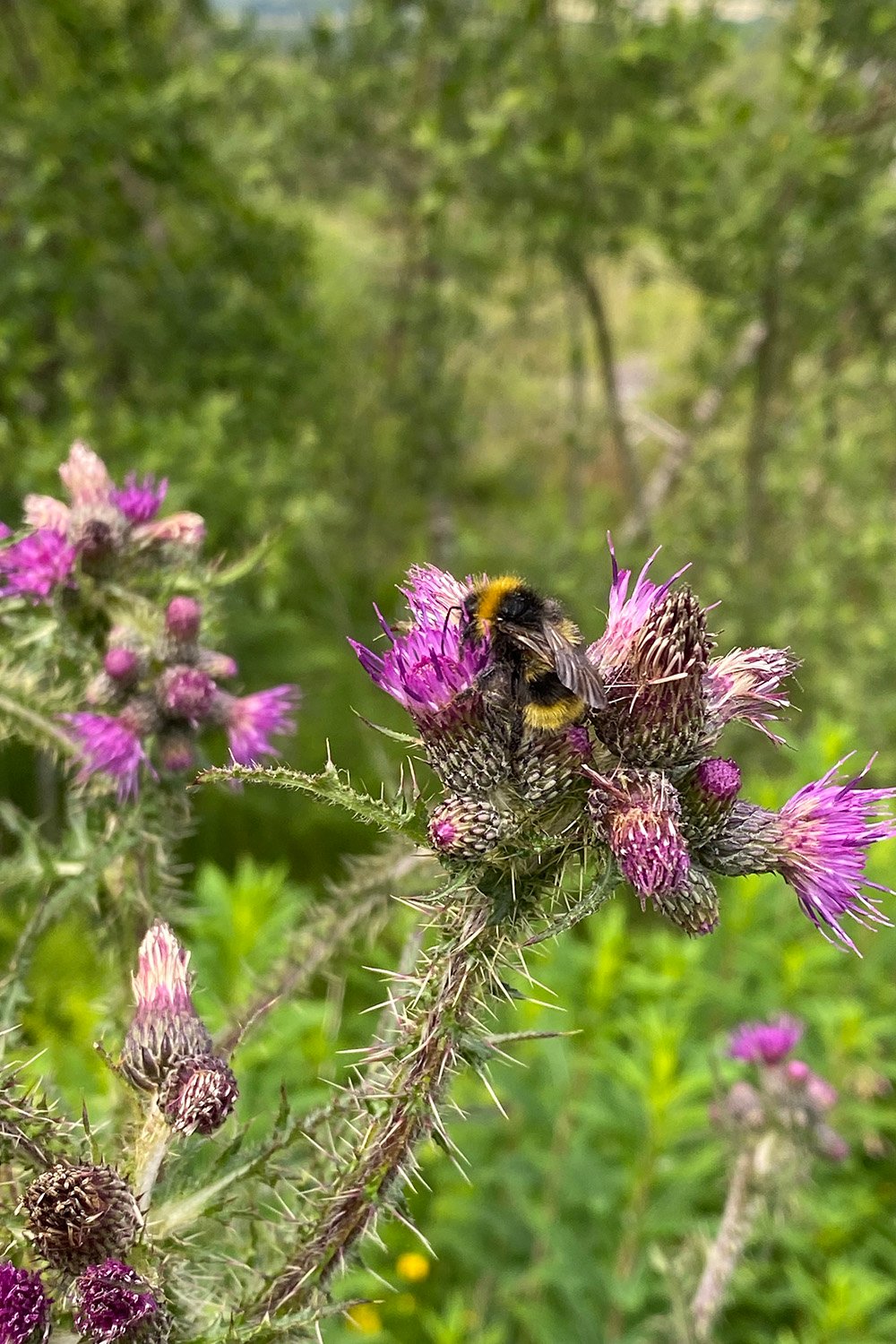
A feast for ladybirds
Thistles also provide a feast for ladybirds in the aphids they support. Some aphids are restricted to thistles. Ladybirds were a great introduction to nature study for me. Grown ups were not afraid of them and liked their colours. But every grown up I knew… parents, butchers, bakers, gardeners and teachers, were united in their hatred of ladybird food… aphids. I am over-simplifying things a bit here but on the whole, if we exterminate aphids, there’ll be no ladybirds and with no ladybirds, there’ll be lots more aphids. I’ve had my share of aphid problems when rearing rare barberry carpet moth caterpillars on netted plants. The answer was to cut a slot in the netting to allow ladybirds in. The caterpillars were left alone and had no interest in leaving the plant. But a zip was required when they emerged as moths! The important thing to remember is flow.
Just as cash flow is important to any business and nectar flow is important to pollinators, prey flow is important to ladybirds and feathery birds. Food has to be available to them throughout their active season or they will dwindle away.

INSECTS ON THISTLE
Super Nettles
Like thistles, nettles in nuisance places get moved to a corner where they can live without harming or scaring us. They are, extremely nutritious and have a wonderful history and folklore. More importantly for the wildlife gardener, they are among the most important of foodplants for some of the prettiest and most important insects. The peacock, comma, small tortoiseshell and red admiral all feed on stinging nettles as caterpillars. If there are fewer stinging nettles and if they are mown too early in gardens, parks and roadside verges, there will be less, or even none of these beauties in our lives or the lives of our children and grand children. And that’s without pollution, we can strim them into extinction (whilst contributing to global warming through fuel consumption) and we are doing exactly that; great multi-tasking!
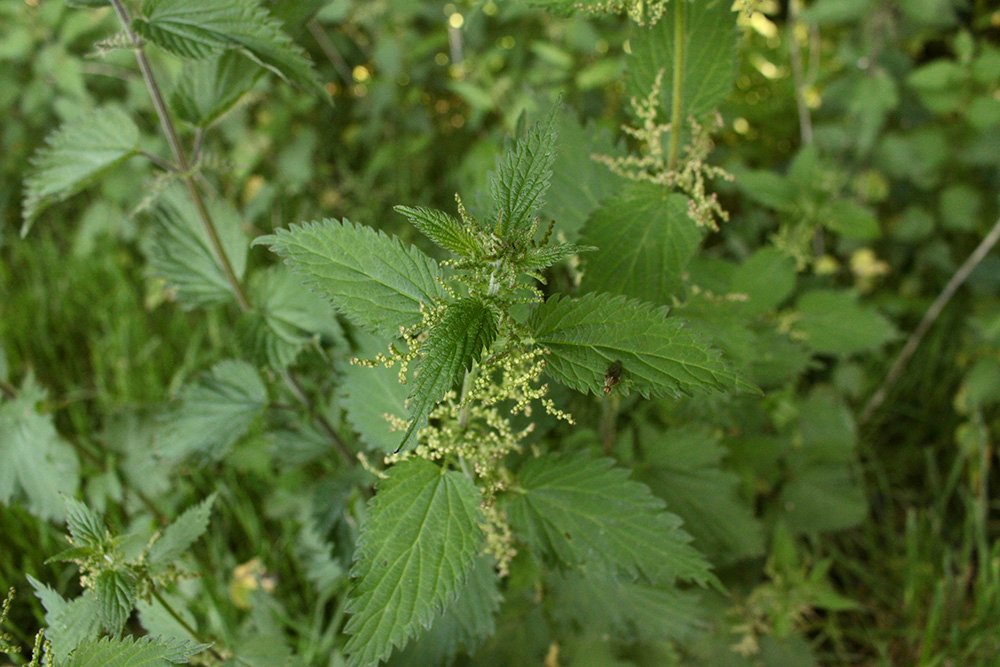
For those of us who… HATE BUTTERFLIES (isn’t that a funny thing to say) there are other benefits to nettles. Moths, the buff ermine, small magpie, snout and angle shades moths, for instance, among others, feed on nettles as caterpillars. For those who HATE MOTHS there is still good reason to persevere and give a little bit of your paradise to nettles. Bats eat moths and hedgehogs eat (and need) many of the invertebrates that virtually depend on a nettle patch or wild corner. Bats are worth keeping healthy, they also eat midges and mosquitoes.
RARE NETTLES: our vegetable companions
Nettles may seem to be everywhere but they are not as common as we tend to think. I tend to think of them as particularly associated with stables and horse pasture. Beyond populated areas, nettlebeds quickly dwindle away and, if butterflies are dependent on such beds, which only occur around our living places and we are irritated by them and eradicating them, where does that leave butterflies.
Oliver Rackham in his History of the Countryside (1986) said:
Stinging nettle[s] are significant because they live on phosphate, and mankind is a phosphate accumulating animal. Most ancient woods are short of phosphates, which is one reason why they are still woods, and these plants will not grow in them. Phosphate plants grow where people have lived (and especially where they have died), and where they have thrown bones and the ashes of faggots. The phosphate thus accumulated lasts for centuries in non-acid soils. Little Gidding (Huntingdonshire) the famous deserted village forgotten by 1640, is still marked by an elm-grove full of ear-high nettles. On the Grovely Ridge near Salisbury, patches of phosphate plants in the woods mark where Romano-British villages were abandoned over 1600 years ago.
Oliver Rackham
Notable Nettle Nibblers
Butterflies
- Comma Butterfly Polygonia c-album
- Painted Lady Cynthia cardui
- Peacock Aglais io
- Red Admiral or Red Admirable Vanessa atalanta
- Small Tortoiseshell Butterfly Aglais urticae
Moths
- Angle Shades Phlogphora meticulosa
- Bright-line brown-eye Lacanobia oleracea
- Burnished Brass Diachrysia chrysitis
- Cream-spot Tiger Arctia villica
- Dark Spectacle Abrostola trigemina
- Dot Melanchra persicariae
- Gold Spangle Autographa bractea
- Mottled Rustic Caradrina morpheus
- Plain Golden Y Autographa jota
- Scarlet Tiger Callimorpha dominula
- Silver Y Autographa gamma
- Snout Hypena proboscidalis
- Spectacle Abrostola triplasia
Ladybird beetles (Family Coccinellidae)
benefit from aphids and protection, especially:
- Two Spotted Adalia 2-punctata or Adalia bipunctata,
- Seven Spotted Coccinella 7-punctata,
- Ten Spotted Adalia 10-punctata
- Fourteen Spotted Propylea 14-punctata
Birds
The inconspicuous flowers are attractive to some insects and the seeds are eaten by birds including sparrows
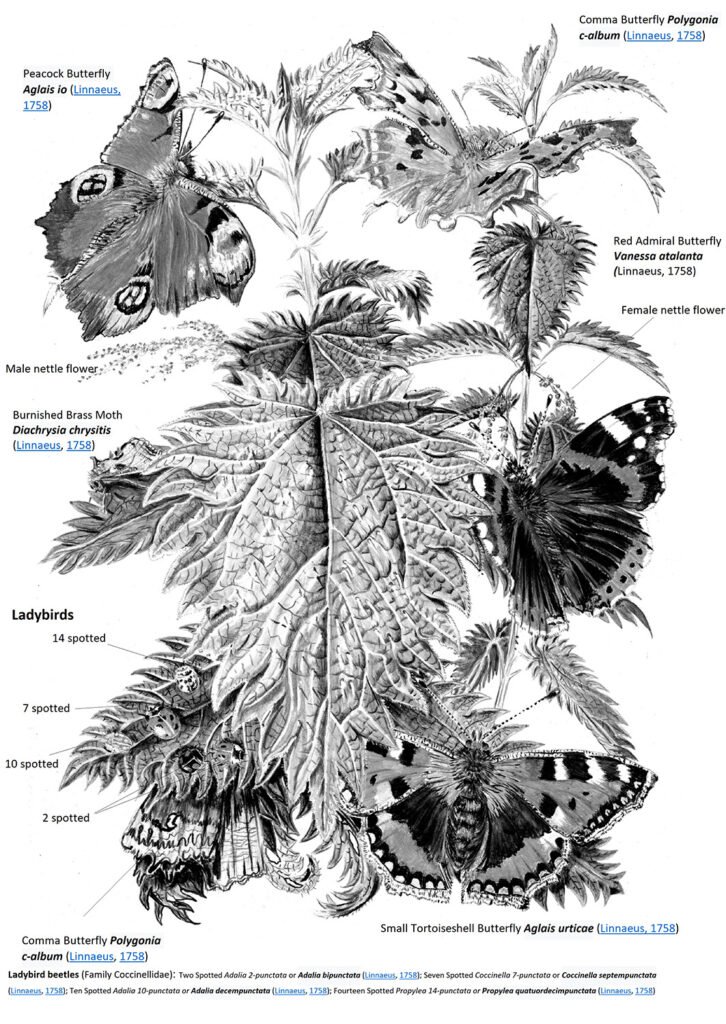
Dock (Rumex) THE GARDEN DOCTOR
Here, I’m talking about the various species of Dock, particularly broad-leaved dock (Rumex obtusifolius) and the similar curled Dock (Rumex crispus). But please also count in other Rumex species such as sorrel (Rumex acetosa) which is very tasty in salads.
Everything the nettle does for insects, hedgehogs and bats, the dock does too, but for a mostly different selection. By tolerating them, your garden biodiversity is growing and planetary health is returning. By doing nothing you are saving life on earth. Though the nettle is spared official pariah status, the common dock species: curled dock (Rumex crispus) and broadleaved dock (Rumex obtusifolius) are included on the Weeds Act (1959) too.
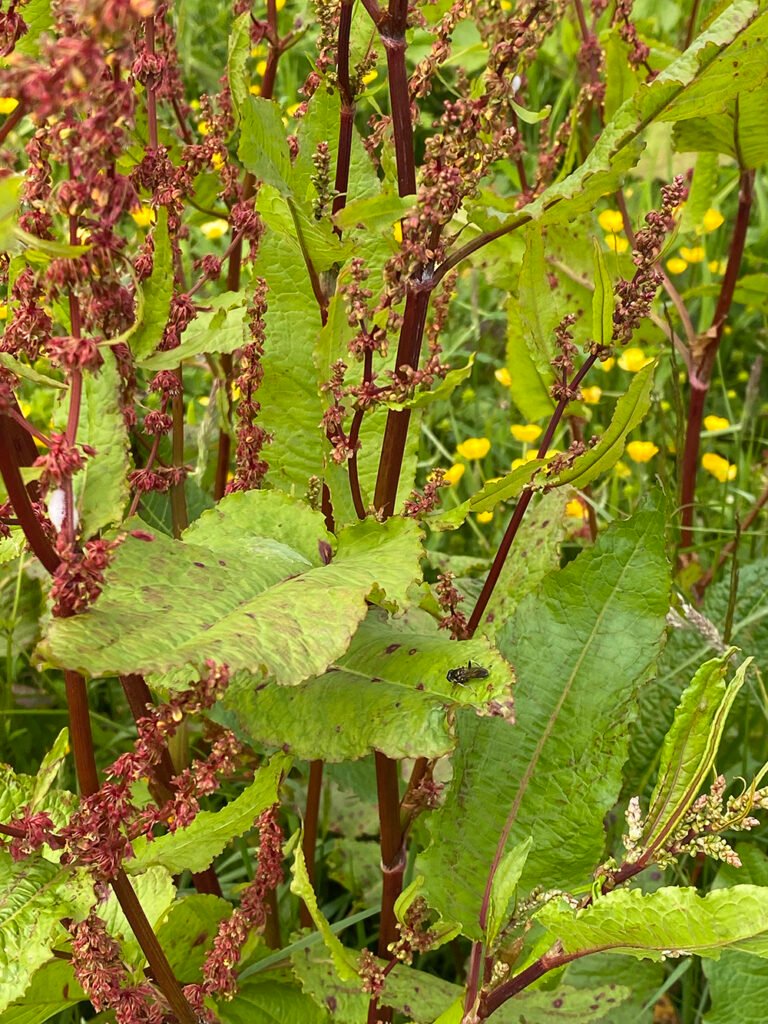
The green dock beetle is a lovely little living jewel. The plant also feeds the larvae of a wide range of other insects such as the old lady, gothic, red chestnut, yellow underwing, flame, shuttle-shaped dart, scarlet tiger, ruby tiger and buff ermine moths to mention just a few. The dock has many mouths to feed and deserves some respect.
Renowned Ruminators of Rumex; Docks and Sorrels
Butterflies
- Small Copper Lycaena phlaeas
- Large Copper Lycaena dispar – Declared extinct in the British Isles in 1851
Moths
- Angle Shades Phlogphora meticulosa – Also feeds on Bramble, Barberry and others
- Ashworth’s Rustic Xestia ashworthii
- Barred Chestnut Diarsia dahlia
- Beaded Chestnut Agrochola lychnidis – Also feeds on Buttercup, Chickweed, Dandelion, Groundsel and others
- Beautiful Brocade Lacanobia contigua
- Bird’s Wing Dypterygia scabriuscula
- Black Rustic Aporophyla nigra – Also feeds on Clover
- Blood Vein Timandra griseata
- Bright-line brown-eye Lacanobia oleracea
- Broad-bordered Yellow Underwing Noctua fimbriata
- Brown-spot Pinion Agrochola litura
- Clouded Buff Diacrisia sannio
- Common Emerald Hemithea aestivaria
- Double Square-spot Xestia Triangulum – Also feeds on Buttercup
- Engrailed Clay Diarsia mendica
- Fiery Clearwing Bembecia chrysidiformis
- Flame Axylia putris
- Forester Adscita statices
- Garden Dart Euxoa nigricans
- Garden Tiger Arctia caja
- Gem Orthonama obstipata
- Gothic Naenia typica
- Green Arches Anaplectoides prasine
- Grey Arches Polia nebulosa
- Heart and Dart Agrotis exclamationis
- Hebrew Character Orthosia gothica
- Knot Grass Acronicta rumicis
- Large Yellow Underwing Noctua pronuba
- Lesser Yellow Underwing Noctua comes
- Muslin Moth Diaphora mendica
- Old Lady Mormo maura
- Pearly Underwing Peridroma saucia – Also feeds on Dandelion and Clover
- Plain Clay Eugnorisma depuncta
- Plain Wave Idaea straminata
- Purple Clay Diarsia brunnea
- Red Chestnut Cerastis rubricosa
- Riband Wave Idaea averstata
- Rosy Rustic Hydraecia micacea
- Ruby Tiger Phragmatobia fuliginosa
- Rustic Hoplodrina blanda
- Scarlet Tiger Callimorpha dominula
- Setaceous Hebrew Character Xestia c-nigrum
- Shoulder-striped Wainscot Mythimna comma
- Shuttle-shaped Dart Agrotis puta
- Six-striped Rustic Xestia sexstrigata
- Square-spot Rustic Xestia xanthographa
- Stout Dart Spaelotis ravida
- Triple Spotted Clay Xestia ditrapezium
- Turnip Moth Agrotis segetum
- Yellow Shell Camptogramma bilineata
(now that’s a lot of moths!)
Beetles
- Green Dock Beetle Gastrophysa viridula
- Ladybirds benefit from Dock and Sorrel just as much as they do from Nettle and Thistle

Dock, quietly sitting there, is a busy restaurant and when you consider how dependent most British song birds are on moths and other insects, the loss of Dock from gardens must seriously contribute towards silent springs. A few minutes ago, lunching outside, we watched a sparrow stuffing her beak with aphids from the dock stems. She then moved onto the rose. Bats too depend almost entirely on flying insects, particularly moths, midges and beetles.
According to Nicholas Culpeper, docks are,
“as wholesome a pot-herb as any that groweth in the garden; yet such is the nicety of our times, forsooth, that women will not put it into the pot, because it makes the pottage black; pride and ignorance (a couple of monsters in the creation) preferring nicety before health.”
Nicholas Culpepper
Busy doing nothing
Dock is the last of my Holey Trinity. My plea is for you to do nothing, in just a small area of your garden and let these oh so important beauties thrive. It really really helps. Our T-shirt tribute to nettles will be available soon.


Fascinating and illuminating. Thank you for sharing your knowledge and insights. Just removed the neighbor’s ‘contribution’ of thistle to my brick walkway. After reading your article, maybe I’ll just plant to weed my side and appreciate their wild yard. Without making a complaint to the city. YOU made a difference today! Because of your page, I’ll make a difference today too. And next time, I’ll put the thistle in a pot and let it thrive in a small place here too. Thank you!
Many many thanks for this. It is very useful to know when we hit the mark. I absolutely agree with you that just little steps by everyone, will be enough to provide for wildlife for generations.
Good luck with your potted thistles, I would love to see a photo when you get to stage where you are pleased with them.
Best wishes
Ian